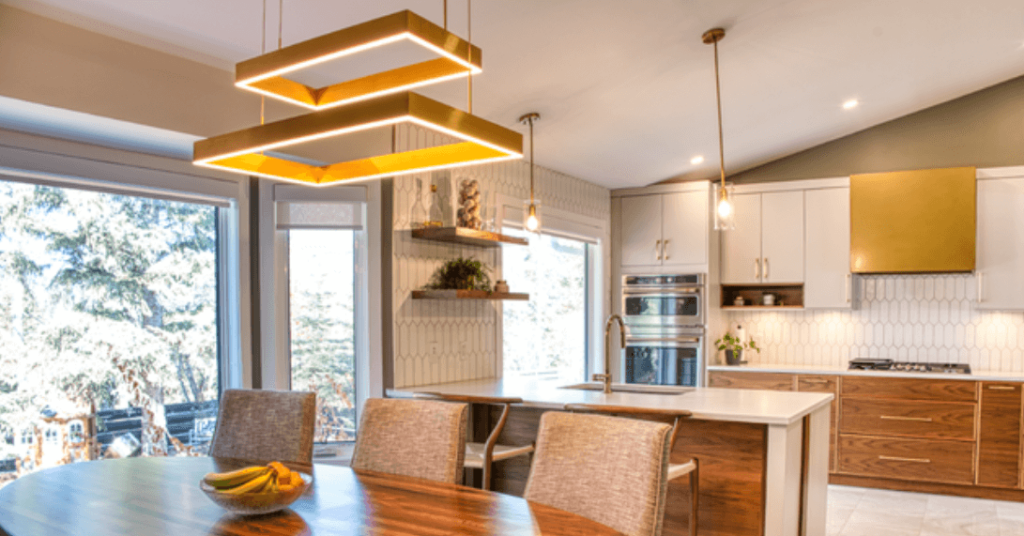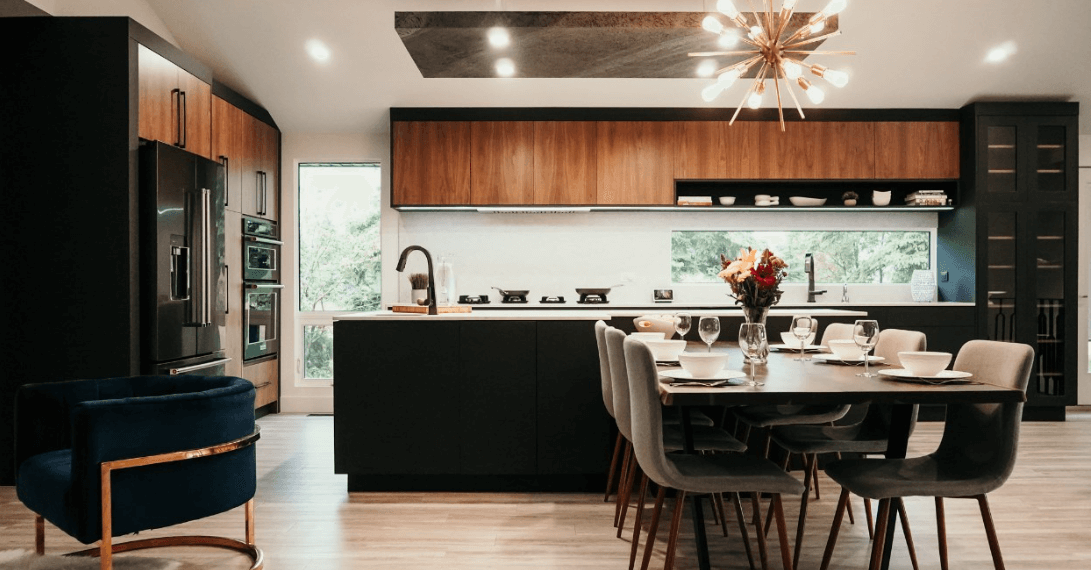If one area within the home undoubtedly deserves a touch of luxury, it’s the kitchen. More than just a functional space for cooking, the kitchen, in its best form, is a hub for socializing, relaxing, and indulging in culinary delights. This guide is designed to assist those considering a high-end kitchen renovation and aims to provide invaluable insights into the world of luxury kitchen designs. So, whether you are an ardent home chef seeking to transform your cooking space into a culinary masterpiece or simply someone who appreciates the finer things in life, you’re in the right place. Let’s embark on this exciting journey of turning your kitchen into an epitome of luxury and sophistication.
The Importance of a Well-Designed Kitchen
An elegantly designed kitchen is an aesthetic delight and a significant contributor to the overall value of a home. Real estate experts often emphasize that a kitchen’s design can drastically influence a property’s market value. A well-thought-out, high-end kitchen renovation has the potential to provide a return on investment of between 60 to 120 percent, according to The National Association of Realtors.
Aside from the monetary value, the kitchen’s design greatly impacts the lifestyle and comfort of the home’s inhabitants. Whether you’re an avid cook or prefer take-out, having a functional, comfortable, and inviting kitchen enhances your everyday life. A well-designed kitchen encourages healthier eating habits, promotes social engagement, and provides a warm, welcoming space for family and guests. Kitchen designs have evolved remarkably over the years, transforming from purely utilitarian spaces to becoming the heart of the home. Initially, kitchens were designed for efficiency, focusing on easy cleaning and storage. However, the turn of the century saw an emergence of open-plan kitchens that promote interaction, with integrated living spaces becoming a staple in modern households. Today, luxury kitchen designs blend functionality with bespoke aesthetics, incorporating high-end appliances, superior materials, and innovative technology, all tailored to the homeowner’s unique tastes and lifestyle.
Latest Trends in High-End Kitchen Renovations
Luxury kitchen renovations are about personalization, emphasizing high-quality materials and cutting-edge appliances. Here are some of the latest trends to look out for:
- Smart Kitchens: The Internet of Things (IoT) has brought smart technology into the kitchen. From refrigerators that can reorder groceries to ovens that can be controlled remotely, smart technology offers convenience and efficiency like never before.
- Minimalistic Design: The “less is more” philosophy is entering luxury kitchen design. Clean lines, clutter-free countertops, and streamlined cabinetry create a sleek, modern aesthetic. Simple yet sophisticated, minimalistic kitchens boast a timeless appeal.
- Sustainable Materials: Increasing environmental awareness has led to a rise in using sustainable materials in kitchen renovations. Reclaimed wood, bamboo, and recycled glass are popular choices contribute to a kitchen’s eco-friendly footprint.
- Multipurpose Islands: Kitchen islands are becoming the centrepiece of high-end kitchen designs. They’re no longer just about extra counter space; multifunctional islands now incorporate dining areas, storage solutions, and cooking facilities.
- Bold Colors: While white kitchens are a classic choice, bold colours are gaining popularity. Vibrant hues make a splash, adding personality and depth to luxury kitchen designs.
- Custom Storage: Custom storage solutions are rising as more homeowners seek to declutter and organize their kitchens. These can range from pull-out pantry shelves to bespoke cutlery trays designed to optimize every inch of kitchen space.
These trends highlight the shift towards equally functional and visually impressive kitchens and the continuous integration of technology and sustainable practices within luxury kitchen renovations.
Choosing the Right Materials
Selecting the right materials is an essential part of any high-end kitchen renovation. The chosen materials directly impact the kitchen’s aesthetics, functionality, and lifespan. Here, we delve into the pros and cons of various materials for countertops, cabinets, flooring, and more, so you can make an informed decision.
Countertops
- Granite: Granite countertops are synonymous with luxury due to their sleek and elegant appearance. They are incredibly durable, heat resistant, and available in various colours. The main drawback is their porosity, which requires sealing to prevent stains.
- Marble: It’s heat resistant and perfect for baking areas. However, due to its soft nature, it can scratch easily and is prone to staining if not properly sealed. Marble is a classic choice offering unmatched, timeless beauty, however not the countertop material of choice for MOD.
- Quartz: Quartz countertops are non-porous, highly durable, and come in various colours and patterns. They do not require sealing but can discolour when exposed to direct sunlight.
Cabinets
- Hardwood: Hardwood cabinets such as oak, maple, and cherry are reliable for their long-lasting nature. They lend a warm, inviting look to the kitchen but can show wear and tear over time.
- Plywood: Plywood cabinets are less expensive than hardwood but offer comparable durability. They resist warping and are easy to paint, but the grain pattern can be less appealing.
- MDF: Medium-density fiberboard (MDF) is even more cost-effective. It offers a smooth surface for painting and can mimic the look of natural wood. However, it’s not as durable and can swell when exposed to water.
Flooring
- Hardwood: Hardwood floors are classic, warm, and durable. They can be refinished several times to remove wear and tear but can be prone to water damage.
- Tile: Tile flooring is durable, water-resistant, and low-maintenance. It comes in many styles and colours but can be cold and hard underfoot.
- Vinyl: Vinyl flooring offers a budget-friendly option that can mimic the look of natural materials. It’s comfortable underfoot and easy to install but is not as durable as hardwood or tile.
Balancing style and functionality is essential when choosing materials for your kitchen renovation. Consider your kitchen’s daily use, lifestyle, and aesthetic preferences. Remember that while certain materials may require a higher upfront cost, their durability can provide cost savings in the long run.
Innovative Layout Designs
When planning a high-end kitchen renovation, the layout is a crucial element to consider. It determines the functionality and flow of your kitchen space. Here are a few popular kitchen layout designs and how they can cater to different kitchen sizes and household needs:
- L-Shaped Kitchens: This layout consists of countertops on two adjoining walls forming an “L.” It’s an excellent choice for small to medium-sized kitchens, offering plenty of workspace and promoting efficient movement. For example, a high-end L-shaped kitchen might feature a stylish quartz countertop complemented by custom hardwood cabinetry.
- U-Shaped Kitchens: U-shaped kitchens, or “Horseshoe” kitchens, have three walls of cabinets and appliances. This design is suited to larger kitchens and households that require ample storage and preparation space. An upscale U-shaped kitchen might incorporate luxury appliances seamlessly integrated into custom cabinetry, with a durable quartz countertop wrapping around the room.
- Island Kitchens: Island kitchens feature a freestanding workspace in the middle of the kitchen, which can function as a cooking area, additional storage, or casual dining spot. This layout works well in large, open-plan kitchens. A high-end example could include a large, multifunctional island with a built-in cooktop and a stylish breakfast bar, all topped with stunning granite.
Choosing the right layout for your kitchen depends on the size and shape of your space, your cooking habits, and your storage needs. It’s essential to consider how you use your kitchen daily – whether you often have multiple cooks, dine in the kitchen, or require a lot of storage space. With careful planning and a thoughtful design, your kitchen layout can significantly enhance your space’s functionality and aesthetic appeal.

Lighting and Ambiance
The importance of lighting in kitchen design cannot be overstated. A well-lit kitchen ensures safety while cooking, enhances the space’s aesthetic appeal, and creates a warm and welcoming ambiance. Carefully chosen and strategically placed lighting fixtures can transform your kitchen from a purely functional space into a culinary masterpiece.
Task Lighting
Task lighting is crucial in areas where you’ll be prepping and cooking food. This might include under-cabinet lights illuminating countertops or pendant lights over an island. Opt for bright, focused lights in these areas to ensure visibility while chopping, mixing, and cooking.
Ambient Lighting
Incorporate ambient lighting into your kitchen design for a welcoming, cozy feel. This might include recessed or track lighting that casts a soft, diffused light throughout the space, offering an overall illumination.
Accent Lighting
Accent lighting can highlight design elements in your kitchen, such as open shelving, glass-fronted cabinets, or a tile backsplash. This type of lighting can add depth and dimension to your space.
Choosing the Right Light Bulbs
When selecting light bulbs, consider not just their brightness but also their colour temperature. Warm white bulbs can create a cozy, inviting atmosphere, while cool white bulbs offer a more modern, clean look.
Remember, good kitchen lighting is layered, combining different types of light to create a balanced, functional, and inviting space. With careful planning and selecting the right fixtures and bulbs, you can ensure your kitchen is functional and a joy to spend time in.
Working with Professionals
When embarking on a high-end kitchen renovation, partnering with experienced professionals such as designers, contractors, and architects can be incredibly beneficial. These experts can help transform your kitchen vision into a tangible reality, guiding every stage of the renovation process.
Selecting Professionals
When choosing professionals to work with, it’s essential to consider their experience, portfolio, and testimonials from previous clients. Ensure their design style aligns with your aesthetic preferences and their past work reflects a high level of craftsmanship. Conduct interviews to gauge their understanding of your project and see if their communication style resonates with you.
The Role of Designers
Kitchen designers play a crucial role in marrying functionality with style. They can assist you in choosing materials, lighting, and appliances, ensuring everything harmonizes aesthetically while catering to your cooking and storage needs. Designers also understand kitchen design’s latest trends and innovations, allowing you to create a contemporary and timeless space.
The Role of Contractors
Contractors are responsible for overseeing the actual renovation process. They ensure the renovation meets the agreed-upon design, timeline, and budget. A reliable contractor will coordinate the various tradespeople involved in the project, manage any unexpected issues that may arise, and keep you informed throughout the process.
The Role of Architects
If your kitchen renovation involves structural changes, such as removing walls or adding extensions, you may need to work with an architect. Architects can help navigate building codes and permits, and their expertise ensures your renovated kitchen is beautiful, structurally sound, and safe.
Working with professionals might seem like an added expense, but their knowledge and expertise can save you from costly mistakes and ensure the success of your renovation. They can provide invaluable advice, offer innovative solutions, and ultimately help you create a functional, beautiful, and enjoyable kitchen.
Conclusion
Designing a high-end kitchen is a complex undertaking that involves careful planning and thoughtful decisions. The key elements to consider include the kitchen layout, which should suit your space and daily cooking habits, and the selection of high-quality materials and appliances that are both durable and visually appealing. Lighting is another crucial aspect of kitchen design, with a combination of task, ambient, and accent lighting contributing to a functional and inviting space. Lastly, working with experienced professionals such as designers, contractors, and architects can provide invaluable guidance and ensure the success of your kitchen renovation project. A well-designed high-end kitchen enhances the aesthetic appeal of your home and significantly improves your cooking and dining experience. It can become a space for culinary creativity, social interaction, and enjoyable living. It is an investment that adds substantial value to your home and improves your quality of life.
Get a detailed quote from MOD Kitchens for your dream kitchen renovation today! Our quotes include all materials and labor costs, ensuring you get beautiful custom cabinets and more that will last years. Don’t wait. Take the first step towards your dream kitchen now! Contact MOD Kitchens today.

